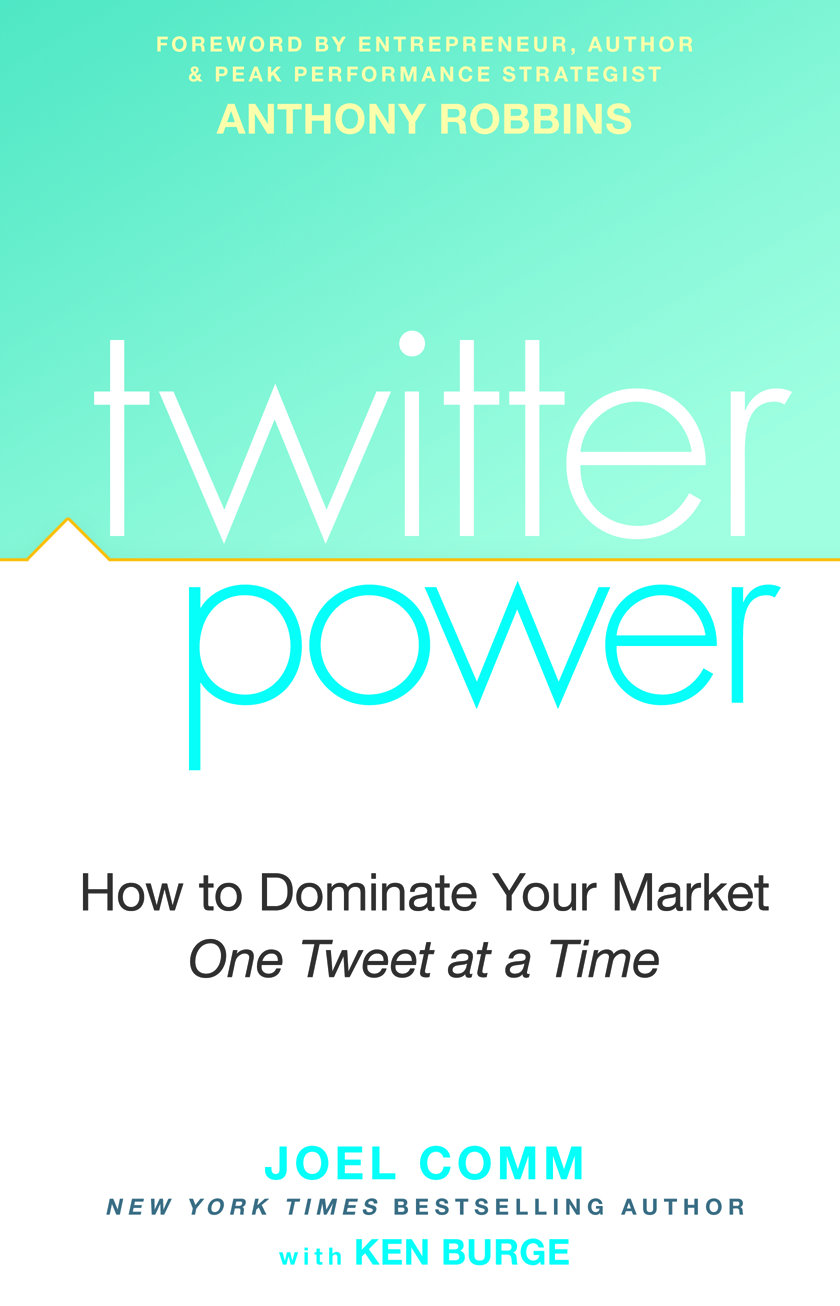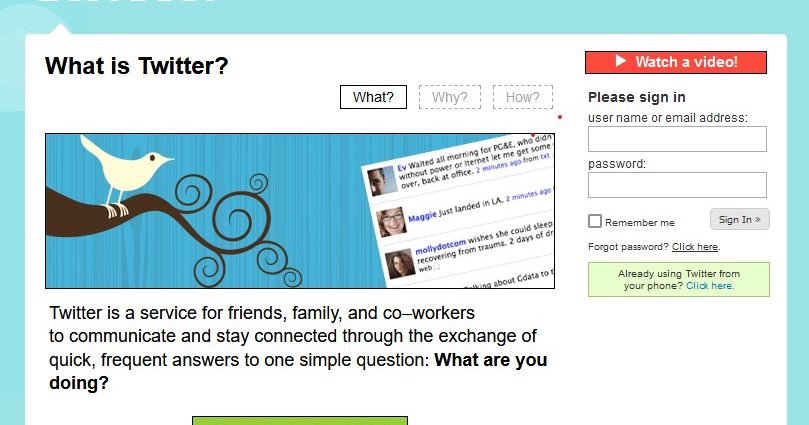 Everyone seems to be using Twitter to help build their brands. And while it is no substitute for a major ad campaign, it costs nothing, except for staff time. Think of it as your own little wire service or ticker tape. Below, an excerpt from the new book Twitter Power by Joel Comm and Ken Burge. It’s got alot of good, basic things on how you use Twitter to promote your business.
Everyone seems to be using Twitter to help build their brands. And while it is no substitute for a major ad campaign, it costs nothing, except for staff time. Think of it as your own little wire service or ticker tape. Below, an excerpt from the new book Twitter Power by Joel Comm and Ken Burge. It’s got alot of good, basic things on how you use Twitter to promote your business.
Every conversation has rules. We know not to interrupt someone when they’re talking. We know not to use bad language when we talk. We know not to talk too loudly. And we know too how and when to break all of the rules.
Exactly the same is true for a Twitter conversation. The site hasn’t been around for long, but Twitterers have already tried to figure out something like a Twittering etiquette.
Some of those etiquette rules are smart, sensible, and should always be followed. Others are smart, sensible, and should usually be followed. While it’s important to know the rules, it’s just as important then to know when to break them — and what happens when you do.
1. Don’t spam. This is one rule you can’t break. Spammers don’t survive long on Twitter. They don’t build followers. Any followers they do get don’t read their tweets and the number of conversions they can generate will be so tiny that as a marketing method, you’d probably be better off printing a thousand flyers, folding them into paper airplanes and tossing them out of your office window.
There are all sorts of different ways to spam on Twitter. As we’ve seen, one way is to follow lots and lots of people in the hope that some of them follow you in return. That’s not just ineffective, it also turns up clearly in your bio. Whenever someone’s bio shows that they’re following several thousand people but only being followed by a handful, that’s a pretty good sign that they’re looking to spam. They’re trying to build up followers who will follow them out of politeness rather than because they have interesting content.
Twitterers often steer clear of people like that. The spamming itself though is done by constantly sending out tweets that say things like: “I’ve just put up a new blog post — check it out!” or “Sign up for my RSS feed!” You can send out tweets like this occasionally. But as we’ll see later in this section, they have to be mixed in with other tweets too. Otherwise, you’re just spamming, and that’s annoying. Worse, it doesn’t work.
2. Follow style rules. Twitter’s founders may have had mobile phones in mind when they designed the service, and plenty of users may be typing their updates from their handheld devices, but Twitter isn’t exactly the same as SMS messaging. That means the language needs to look more like real words than the usual SMS-style abbreviations.
It goes without saying that typing in uppercase letters looks like you’re shouting, but in addition to avoiding all uppercase, you should spell out words completely and avoid using numbers instead of letters whenever possible. (For example, “late” is not spelled “l8” and “to” is two letters, not one number.)
That might mean more typing, but the reasoning is sensible. “Heading 2 town l8. Dont nowot 4” is hard for the reader to understand. It’s only good manners — and good marketing sense — for you to put in the work so that your readers don’t have to.
There are exceptions, of course. If you’re really strapped for space, this is a rule you can break, but understand that you’re forcing your followers to make an effort. What is permissible, though, is to use symbols such as @ and=and to skip some of the grammar. The question Twitter asks might be “What are you doing now?” but you don’t have to begin your answer by saying “I am . . . “Sentence fragments such “About to start watching the football. Can’t wait.” are fine.
3. Give credit for retweets. One of the things that makes Twitter such a powerful tool is the fact that information placed on the site can quickly go viral. When one person spots a good tweet, they can pass that message on to their own followers, and soon it’s spreading right across the Twitterverse and beyond.For a marketer, that’s like hitting the jackpot. On Twitter, it’s done by retweeting. Twitterers can simply copy someone else’s tweet and tweet it themselves . . . but they must give credit to the original Twitterer. The format for retweets, then, looks like this:”Retweet @username: original tweet.”
The etiquette is simple enough. Sharing tweets is easy to understand, too. It might not be original content, but if your followers would find the original tweet interesting, why shouldn’t you share it?The tricky bit is to get other people to retweet for you. While you can ask specifically for retweets – and some people do – it’s not really good form.
If your tweets are interesting enough, people will share them with their friends and followers – and those friends and followers will come to your page to find out who you are.
4. Stick to 140 characters. You have to stick to 140 characters, right? That’s all they give you, and they do it for a good reason. Being starved of space stops you waffling and sparks your creativity. It’s what Twitter is all about. Well, yes and no.
Twitter gives you 140 characters because that’s all that can fit through SMS systems. If mobile phone companies could handle messages of 200 characters, then that’s probably how long our tweets would be.Even though the limit is fairly arbitrary, it does make sense to keep to it as much as possible. The alternative is to show half-complete tweets and offer links for people to continue reading or break messages up so that they’re sent over several tweets.
You can see this happening sometimes on Twitter, and it rarely looks good. Readers expect the content on Twitter to be small. They expect to be able to read and absorb it in one bite. These are content snacks, not three-course meals with coffee. Writing a thought that takes more than 140 characters and spreading it over three or four tweets is giving people more than they want. It also makes you look like you’re dominating the conversation.
Chat with a friend, and you’ll take turns speaking. You’ll speak, your friend will respond, and then you’ll continue. Keep talking without giving your friend a chance to offer his response and you’ll start to sound rude. Multiple tweets can have the same effect upon Twitter. Again, this doesn’t mean you should never break up a long tweet. And it certainly doesn’t mean that you shouldn’t post one tweet after another. What it does mean is that you should be aware of the effect you can create in your timeline when you do either.
5. Follow people who follow you. How many people you should follow on Twitter can always make for a great discussion point. Follow thousands of people and you’re not going to be able to read all of their tweets. Inevitably, you’ll miss tweets you’d really like to read, and you’ll look like someone who has lots of acquaintances but no real friends.
In practice, it doesn’t always work this way. I follow more than 1,700 people. That’s a lot less than the 4,500 or so who follow me, and while I know I’m missing tweets, I love the fact that when I look at my Twitter page I can see a huge variety of different conversations taking place.It’s a bit like strolling through the lobby during a break at a conference. I can choose which conversations to join and which to walk past. I find it very valuable, but I also don’t want to overdo it so I don’t follow everyone who follows me.
That makes me a feel a little rude, but I do feel that I have to control the number of tweets that pass across my home page and keep them focused on conversations that relate to Internet marketing. You might feel different.
You might want – at least at the beginning – to reward everyone who follows you by following them in return. There are plenty of top Twitterers who do this. Similarly, you might prefer only to follow close friends and people you already know. That will make you look antisocial and cliquey, which is not the best image for a marketer, but it’s possible.Ultimately, I think this is one place where eventually you have to skip the etiquette and do what works. As your follower list grows, you’ll have to start being a little bit choosier about who you follow in return – and your followers will just have to understand that you’re being selective, not rude.
Conclusion
Spend any time on Twitter and you’re going to come across plenty of other rules too. Some purists, for example, argue that your tweets should only describe what you’re doing, not what you’re thinking or planning to do. I think that’s far too restrictive: if it sparks a conversation and entertains your followers, it’s a fair topic. If they don’t like it, they should read someone else’s tweets.
And that’s really the ultimate test of tweet etiquette: how other people react and how you would react to the same kind of thing.
If you’re building followers and they’re responding to what you’re writing, you’re following the right rules.
The above is an excerpt from the book Twitter Power: How to Dominate Your Market One Tweet at a Time by Joel Comm with Ken Burge. The above excerpt is a digitally scanned reproduction of text from print. Although this excerpt has been proofread, occasional errors may appear due to the scanning process. Please refer to the finished book for accuracy.
Copyright © 2009 Joel Comm with Ken Burge, author of Twitter Power: How to Dominate Your Market One Tweet at a Time.













